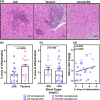Hyperglycemia and Salivary Gland Dysfunction in the Non-obese Diabetic Mouse: Caveats for Preclinical Studies in Sjögren's Syndrome
- PMID: 31784615
- PMCID: PMC6884560
- DOI: 10.1038/s41598-019-54410-9
Hyperglycemia and Salivary Gland Dysfunction in the Non-obese Diabetic Mouse: Caveats for Preclinical Studies in Sjögren's Syndrome
Abstract
The Non-obese Diabetic (NOD) mouse model for type I diabetes also develops some features of Sjögren's syndrome (SS). Since the source of the mice and the environment exert a strong influence on diabetes, this study investigated SS development in NOD mice obtained from two vendors. Female NOD mice from The Jackson Laboratory (JAX) and Taconic Biosciences were monitored for blood glucose and pilocarpine-induced salivation. The gut microbiome was analyzed by 16S rRNA sequencing of stool DNA. At euthanasia, serum cytokines and sialoadenitis severity were evaluated. The onset of diabetes was significantly accelerated in JAX mice compared to Taconic mice. Although the gut microbiome between the two groups was distinct, both groups developed sialoadenitis. There was no correlation between the severity of sialoadenitis and reduced saliva production. Instead, salivary gland dysfunction was associated with hyperglycemia and elevation of serum IL1β, IL16, and CXCL13. Our data suggest that inflammatory pathways linked with hyperglycemia are confounding factors for salivary gland dysfunction in female NOD mice, and might not be representative of the mechanisms operative in SS patients. Considering that NOD mice have been used to test numerous experimental therapies for SS, caution needs to be exerted before advancing these therapeutics for human trials.
Conflict of interest statement
The authors declare no competing interests.
Figures




References
-
- Xiao F, et al. Animal models of Sjogren’s syndrome: an update. Clin. Exp. Rheumatol. 2019;37:209–216. - PubMed
Publication types
MeSH terms
Substances
Grants and funding
LinkOut - more resources
Full Text Sources
Medical
Research Materials
Miscellaneous

